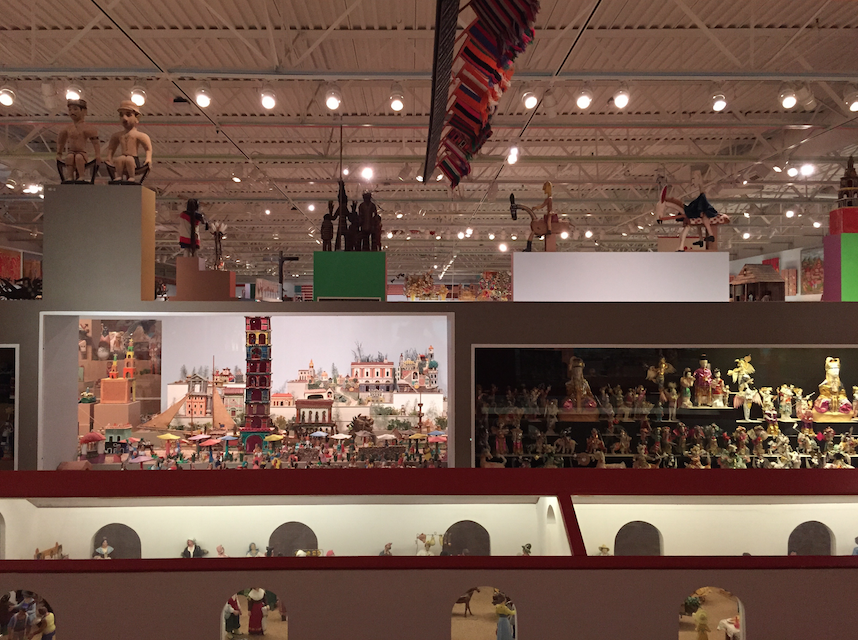The Girard Wing at the Museum of International Folk Art in Santa Fe is louder than a New Mexican Rodeo. Two months ago, I was drawn into this place and emerged deeply struck by such treasure of a collection. It was at a slower speed among the sensual collisions of its thousands of objects—cut, cast, dyed, painted, and woven—that I spiraled upward into a bliss-induced higher state. It was a spiritual experience. I use such language carefully, reserving it for the unpredicted moments when I feel a slowed, embodied awareness of being in the present. When I am centered in place and time. Such were my symptoms in the Girard Wing, which is a place that I’m convinced houses an answer for world peace. There, a story emerged that was rooted in the earthly values of home. Emerging hours later from the museum like Moses from Mount Sinai, I felt the rhythms of the world vibrating from within me, on New Mexican mañana time.
This sanctuary for an assembly of the world’s folk art materializes as the ultimate parade. It clamors like nothing else—riotous, celebratory, euphoric. This place smells of five hundred patinas, weathered by spices, toxic pigments, blunt carving tools, caressing hands, and time. I fantasize about moving my fingers across the sea of objects with their foreign curves, dips, edges, and bends. I’d like to cradle these small tokens and inspect their rich idiosyncrasies: miscast pupils, unusual head-to-body ratios, gracefully imperfect embossing on tarnished metals. As a totally transfixed visitor, I can only smoosh my hands and face against the glass-walled dioramas of miniature wooden sunbathers, terra-cotta market-goers, and the dozen depictions of the Last Supper. And the taste of this place? It would be one reserved for a celebratory feast: a whole animal or two, rubbed with the richest spices, the flavor carnal and righteous.
One of the mid-size dioramas shows a dinner for four: an overflowing cornucopia of miniature toy foodstuffs, arranged with the grace of an ikebana master. Between the cylindrical napkins in their square rings, the staggered trios of drinking glasses, and the wandering flowers that politely nestle between orange toothpick holders and canned anchovies is the negative space of table in foosball green. This harshly luminescent field with the raucous jumble of colors, textures, and forms is like something out of a hungry dog’s dream. I’ve been awakened several times by my girlfriend’s dreaming dog, making gentle yaps and pawing the air, off-tempo. Surely, he dreams of feasts like this.
My favorite item of this table setting is a midnight-gray bottle of Pupsie Cola. Its lower half is a cartoon dog with a poofy tuft of hair and eyebrows stretched high above saucer-like eyes—the frozen look of a surprised yet welcoming dinner host. The cola bottle is the only artwork among the table setting that startled me. It is the only object among the toy fast-food classics, sandwiches, pastries, boxed and bowled candies, fruits, veggies, and proteins to interrupt my slow scan with an unwavering gaze of its own.
When you visit the Girard Wing, I can’t predict what objects will affect you like Pupsie Cola did me, but they’ll be waiting, bringing your slow gallery-shuffle to a cold stop within its Crayola-color catacombs. Maximalist and labyrinthine, the impact of this global metropolis in miniature is assaultive. Into dioramas, high on plinths, and around sharp corners, the visitor is pulled in and around this world’s warehouse. The visitor’s rhythm of moving and looking and reflecting becomes like the gentle, organic float along a water park’s lazy river. Maybe we gravitate to single objects for temporary mooring before being pulled back into the current of bewildering wonders, as wildly exotic as they are comfortably familiar. The single objects, like the Pupsie Cola, speak to a power of folk art that I had underestimated: a power to shift my understanding of humanity from one that is totally abstract to one that is felt immediately.
The folk-art historian Henry Glassie describes the Girard Wing as a place that nudges one towards knowledge.[1] I’d propose other verbs: one is catapulted or jettisoned towards knowledge. One is careened through crystalline space above carnivals and a hundred other celebrations. What a sanctuary, sacred place, survey, portrait of the designer-collector, and gift! Alexander Girard’s choreography with objects and space will bring you into the rhythm that he and his wife, Susan, felt as they hungrily engaged with the folk traditions of many places for almost fifty years.
At the Girard Wing, I received an education on folk art’s most profound and endearing capabilities to communicate the stories that we hold dearest: those of family, community, place, and love. I left with intimately-scaled answers to the bigger questions about the communicative power of folk artworks and their legacies. Within Alexander Girard’s grand space, you too, will find warmth among the intimate comforts of home that glow gently from a hundred thousand beacons, translated across territory and time.
—
[1] Henry Glassie, The Spirit of Folk Art: The Girard Collection at the Museum of International Folk Art (Abrams, 1995).
